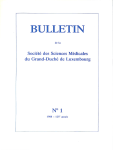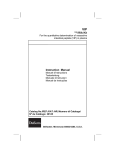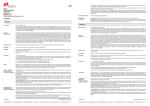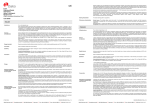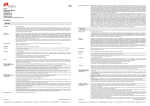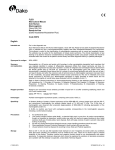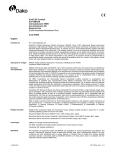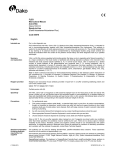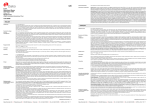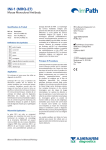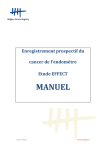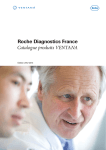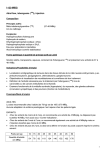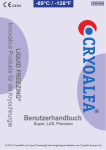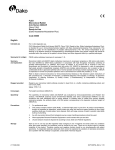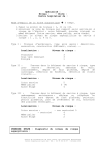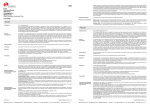Download Monoclonal Mouse
Transcript
FLEX Negative Control Mouse Cocktail of mouse IgG1, IgG2a, IgG2b, IgG3 and IgM Ready-to-Use (Dako Autostainer/Autostainer Plus) Code IS750 English Intended use For in vitro diagnostic use. FLEX Mouse Negative Control, Ready-to-Use, (Dako Autostainer/Autostainer Plus), is intended for use in immunohistochemistry together with Dako Autostainer/Autostainer Plus instruments. These antibodies are intended for in vitro diagnostic use as negative control reagents. The use of universal negative control (UNC) antibody is recommended to ascertain nonspecific staining and will allow better interpretation of specific staining at the antigenic site. These reagents may be used to aid in the identification of cells, tissues or tissue components which may nonspecifically bind antibodies. In some tissues, nonspecific binding may occur, especially in neoplastic or necrotic tissue. The clinical interpretation of any staining or its absence should be complemented by morphological studies using proper controls and should be evaluated within the context of the patient's clinical history and other diagnostic tests by a qualified pathologist. Summary and explanation The UNC, Mouse is a cocktail of mouse IgM and the four subclasses of IgG. It may be used in IHC assays where mouse primary antibodies are responsible for antigen specific recognition and binding. Refer to Dako’s General Instructions for Immunohistochemical Staining or the detection system instructions of IHC procedures for: 1) Principle of Procedure, 2) Materials Required, Not Supplied, 3) Storage, 4) Specimen Preparation, 5) Staining Procedure, 6) Quality Control, 7) Troubleshooting, 8) Interpretation of Staining, 9) General Limitations. Reagent provided Ready-to-use mouse negative control antibody provided in liquid form in a buffer containing stabilizing protein and 0.015 mol/L NaN3. Cocktail of mouse IgG1, IgG2a, IgG2b, IgG3 and IgM Specificity The universal negative control will not react with human or animal cells in tissue specimens. Precautions 1. For professional users. 2. This product contains sodium azide (NaN3), a chemical highly toxic in pure form. At product concentrations, though not classified as hazardous, sodium azide may react with lead and copper plumbing to form highly explosive build-ups of metal azides. Upon disposal, flush with large volumes of water to prevent metal azide build-up in plumbing. 3. As with any product derived from biological sources, proper handling procedures should be used. 4. Wear appropriate Personal Protective Equipment to avoid contact with eyes and skin. 5. Unused solution should be disposed of according to local, State and Federal regulations. Storage Store at 2-8 °C. Do not use after expiration date stamped on vial. If reagents are stored under any conditions other than those specified, the conditions must be verified by the user. There are no obvious signs to indicate instability of this product. Therefore, positive and negative controls should be run simultaneously with patient specimens. If unexpected staining is observed which cannot be explained by variations in laboratory procedures and a problem with the antibody is suspected, contact Dako Technical Support. Specimen preparation including materials required but not supplied The antibody can be used for labeling formalin-fixed, paraffin-embedded tissue sections. Tissue specimens should be cut into sections of approximately 4 µm. Pre-treatment with heat-induced epitope retrieval (HIER) is required. Optimal results are obtained by pretreating tissues using EnVision FLEX Target Retrieval Solution, High pH (10x), (Dako Autostainer/Autostainer Plus) (Code K8010/K8014) or EnVision FLEX, Target Retrieval Solution, Low pH (10x), (Dako Autostainer/Autostainer Plus) (Code K8011/K8015). Deparaffinized sections: Pre-treatment of deparaffinized formalin-fixed, paraffin-embedded tissue sections is recommended using Dako PT Link (Code PT100/PT101). For details, please refer to the PT Link User Guide. Follow the pre-treatment procedure outlined in the package insert for EnVision FLEX Target Retrieval Solution, High pH (10x), (Dako Autostainer/Autostainer Plus) (Code K8010/K8014) or EnVision FLEX, Target Retrieval Solution, Low pH (10x), (Dako Autostainer/Autostainer Plus) (Code K8011/K8015). The following parameters should be used for PT Link: Pre-heat temperature: 65 °C; epitope retrieval temperature and time: 97 °C for 20 (±1) minutes; cool down to 65 °C. Rinse sections with diluted room temperature EnVision FLEX Wash Buffer (10x), (Dako Autostainer/Autostainer Plus) (Code K8010). (117249-001) 307511EFG_001 p. 1/7 Paraffin-embedded sections: As alternative specimen preparation, both deparaffinization and epitope retrieval can be performed in the PT Link using a modified procedure. See the PT Link User Guide for instructions. After the staining procedure has been completed, the sections must be dehydrated, cleared and mounted using permanent mounting medium. The tissue sections should not dry out during the treatment or during the following immunohistochemical staining procedure. For greater adherence of tissue sections to glass slides, the use of Dako Silanized Slides (Code S3003) is recommended. Staining procedure including materials required but not supplied The recommended visualization system is EnVision FLEX, High pH, (Dako Autostainer/Autostainer Plus) (Code K8010) or EnVision FLEX, Low pH, (Dako Autostainer/Autostainer Plus) (Code K8011) without or in combination with EnVision FLEX+, Mouse, High pH, (Dako Autostainer/Autostainer Plus) (Code K8012) or EnVision FLEX+, Mouse, Low pH, (Dako Autostainer/Autostainer Plus) (Code K8013). The staining steps and incubation times are pre-programmed into the software of Dako Autostainer/Autostainer Plus instruments, using the following protocols: Template protocol: FLEXRTU2 (200 uL dispense volume) or FLEXRTU3 (300 uL dispense volume) Autoprogram (without counterstaining): mxNeg or Autoprogram (with counterstaining): mxNegH The Auxiliary step should be set to “rinse buffer” in staining runs with ≤10 slides. For staining runs with >10 slides the Auxiliary step should be set to “none.” This ascertains comparable wash times. All incubation steps should be performed at room temperature. For details, please refer to the Operator’s Manual for the dedicated instrument. If the protocols are not available on the used Dako Autostainer instrument, please contact Dako Technical Services. Optimal conditions may vary depending on specimen and preparation methods, and should be determined by each individual laboratory. If the evaluating pathologist should desire a different staining intensity, a Dako Application Specialist/Technical Service Specialist can be contacted for information on re-programming of the protocol. Verify that the performance of the adjusted protocol is still valid by evaluating that the staining pattern is identical to the staining pattern described in “Performance characteristics.” Counterstaining in hematoxylin is recommended using EnVision FLEX Hematoxylin, (Dako Autostainer/Autostainer Plus) (Code K8018). Non-aqueous, permanent mounting medium is recommended. Staining interpretation There should be no specific staining of cells, normal or abnormal tissues with these products. Please see appendices 1 and 2 for lists of tissues tested. Performance characteristics Normal tissues: Adrenal Bone Marrow Brain Breast Cardiac muscle Cerebellum Colon Endometrium Esophagus Heart Kidney Large intestine Liver Lung Abnormal tissues: Alveolar soft part sarcoma Astrocytoma Bladder, transitional cell carcinoma Breast carcinoma Breast carcinoma (metastasized in lymph node) Breast lobular carcinoma Breast small cell carcinoma Cavernous hemangioma Carcinoid tumor Cervix squamous cell carcinoma Cholangiosarcoma Colonic adenocarcinoma Desmoplastic small cell tumor Endometrial carcinoma Endometrial stroma sarcoma Epithelioid sarcoma Ewing’s sarcoma Extraskeletal myxoid chondrosarcoma Fibrous tumor of pleura Fibrous Histiocytoma Ganglioneuroma Gastric adenocarcinoma Gastric adenocarcinoma (metastsized to ovary) Gastric carcinoma (117249-001) Ovary Pancreas Parotid Peripheral blood smears Placenta Prostate Small intestine Spleen Stomach Skin Skeletal muscle Testis Thyroid Tonsil Hepatoma Hepatocellular carcinoma Hodgkin’s lymphoma Islet cell tumor of pancreas Kidney, transitional cell carcinoma Leiomyoma Leiomyosarcoma Liver cell adenoma Lung adenocarcinoma Lung bronchoalveolar carcinoma Lung carcinoma Lung squamous cell carcinoma Lymphoma Lymphoma of secum Melanoma Mesothelioma Ovarian carcinoma Pancreatic carcinoma Prostate adenocarcinoma Prostate BPH Prostatic carcinoma Renal cell carcinoma Rhabdomyosarcoma Solar elastosis 307511EFG_001 p. 2/7 GIST Glial (Ov Imm Teratoma) Français Réf. IS750 Utilisation prévue Pour utilisation diagnostique in vitro. Thymoma Thyroid carcinoma FLEX Mouse Negative Control, Ready-to-Use, (Dako Autostainer/Autostainer Plus), est destiné à une utilisation en immunohistochimie avec les instruments Dako Autostainer/Autostainer Plus instruments. Ces anticorps sont destinés à une utilisation en diagnostic in vitro comme réactifs de contrôle négatifs. L’utilisation de l’anticorps Universal Negative Control (UNC) est recommandée pour confirmer la coloration non spécifique et permettre une meilleure interprétation de la coloration spécifique du site antigénique. Ces réactifs peuvent être utilisés pour faciliter l’identification de cellules, de tissus ou de composants tissulaires pouvant se lier de manière non spécifique aux anticorps. Dans certains tissus, une liaison non spécifique peut se produire, notamment dans les tissus néoplasiques ou nécrotiques. L’interprétation clinique de toute coloration ou son absence doit être complétée par des études morphologiques en utilisant des contrôles appropriés et doit être évaluée en fonction des antécédents cliniques du patient et d’autres tests diagnostiques par un pathologiste qualifié. Résumé et explication L’UNC, Mouse est un cocktail d’IgM de souris et des quatre sous-classes d’IgG. Il peut être utilisé lors de dosages IHC lorsque des anticorps primaires de souris sont responsables de la reconnaissance et de la liaison spécifiques de l’antigène. Se référer aux Instructions générales de coloration immunohistochimique de Dako ou aux instructions du système de détection relatives aux procédures IHC pour plus d’informations concernant les points suivants : 1) Principe de procédure, 2) Matériels requis mais non fournis, 3) Conservation, 4) Préparation des échantillons, 5) Procédure de coloration, 6) Contrôle qualité, 7) Dépannage, 8) Interprétation de la coloration, 9) Limites générales. Réactifs fournis Anticorps de contrôle négatif de souris prêt à l’emploi fourni sous forme liquide dans un tampon contenant une protéine stabilisante et 0,015 mol/L d’azide de sodium. Cocktail d’IgG1, d’IgG2a, d’IgG2b, d’IgG3 et d’IgM de souris Spécificité L’Universal Negative Control ne réagit pas aux cellules humaines ou animales dans des échantillons tissulaires. Précautions 1. Pour utilisateurs professionnels. 2. Ce produit contient de l’azide de sodium (NaN3), produit chimique hautement toxique dans sa forme pure. Aux concentrations du produit, bien que non classé comme dangereux, l’azide de sodium peut réagir avec le cuivre et le plomb des canalisations et former des accumulations d’azides métalliques hautement explosifs. Lors de l’élimination, rincer abondamment à l’eau pour éviter toute accumulation d’azide métallique dans les canalisations. 3. Comme avec tout produit d’origine biologique, des procédures de manipulation appropriées doivent être respectées. 4. Porter un vêtement de protection approprié pour éviter le contact avec les yeux et la peau. 5. Les solutions non utilisées doivent être éliminées conformément aux réglementations locales et nationales. Conservation Conserver entre 2 et 8 °C. Ne pas utiliser après la date de péremption imprimée sur le flacon. Si les réactifs sont conservés dans des conditions autres que celles indiquées, celles-ci doivent être validées par l’utilisateur. Il n’y a aucun signe évident indiquant l’instabilité de ce produit. Par conséquent, des contrôles positifs et négatifs doivent être testés en même temps que les échantillons de patient. Si une coloration inattendue est observée, qui ne peut être expliquée par un changement des procédures du laboratoire, et en cas de suspicion d’un problème lié à l’anticorps, contacter l’assistance technique de Dako. Préparation des échantillons y compris le matériel requis mais non fourni L’anticorps peut être utilisé pour le marquage des coupes de tissus inclus en paraffine et fixés au formol. L'épaisseur des coupes d'échantillons de tissu doit être d’environ 4 µm. Le prétraitement avec un démasquage d’épitope induit par la chaleur (HIER) est nécessaire. Des résultats optimaux sont obtenus en prétraitant les tissus à l’aide de la EnVision FLEX Target Retrieval Solution, High pH (10x), (Dako Autostainer/Autostainer Plus) (Réf. K8010/K8014) ou de la EnVision FLEX, Target Retrieval Solution, Low pH (10x), (Dako Autostainer/Autostainer Plus) (Réf. K8011/K8015). Coupes déparaffinées : Le pré-traitement des coupes de tissus déparaffinés fixés au formol et inclus en paraffine est recommandé à l’aide du Dako PT Link (Réf. PT100/PT101). Pour plus de détails, se référer au Guide d’utilisation du PT Link. Suivre la procédure de pré-traitement indiquée dans la notice pour la EnVision FLEX Target Retrieval Solution, High pH (10x), (Dako Autostainer/Autostainer Plus) (Réf. K8010/K8014) ou la EnVision FLEX, Target Retrieval Solution, Low pH (10x), (Dako Autostainer/Autostainer Plus) (Réf. K8011/K8015). Les paramètres suivants doivent être utilisés pour le PT Link : Température de préchauffage : 65 °C; température et durée de restauration de l’épitope : 97 °C pour 20 (±1) minutes ; laisser refroidir jusqu’à 65 °C. Rincer les coupes avec un EnVision FLEX Wash Buffer (10x), dilué à température ambiante (Dako Autostainer/Autostainer Plus) (Réf. K8010). (117249-001) 307511EFG_001 p. 3/7 Coupes incluses en paraffine : Comme préparation alternative des échantillons, le déparaffinage et la restauration de l’épitope peuvent être réalisés dans le PT Link à l’aide d’une procédure modifiée. Se référer aux instructions du Guide d’utilisation du PT Link. Une fois que la procédure de coloration est terminée, les coupes doivent être déshydratées, lavées et montées à l’aide d’un milieu de montage permanent. Les coupes de tissus ne doivent pas sécher lors du traitement ou lors de la procédure de coloration immunohistochimique suivante. Pour une meilleure adhérence des coupes de tissus sur les lames de verre, il est recommandé d’utiliser des lames Dako Silanized Slides (Réf. S3003). Procédure de coloration y compris le matériel requis mais non fourni Les systèmes de visualisation recommandés sont le EnVision FLEX, High pH, (Dako Autostainer/Autostainer Plus) (Réf. K8010) ou le EnVision FLEX, Low pH, (Dako Autostainer/Autostainer Plus) (Réf. K8011) associés ou non au EnVision FLEX+, Mouse, High pH, (Dako Autostainer/Autostainer Plus) (Réf. K8012) ou le EnVision FLEX+, Mouse, Low pH, (Dako Autostainer/Autostainer Plus) (Réf. K8013). Les étapes de coloration et d’incubation sont préprogrammées dans le logiciel des instruments Dako Autostainer/Autostainer Plus, à l’aide des protocoles suivants : Protocole modèle : FLEXRTU2 (volume de distribution de 200 µl) ou FLEXRTU3 (volume de distribution de 300 µl) Autoprogram (sans contre-coloration) : mxNeg ou Autoprogram (avec contre-coloration) : mxNegH L’étape Auxiliary doit être réglée sur « rinse buffer » lors des cycles de coloration avec ≤10 lames. Pour les cycles de coloration de >10 lames, l’étape Auxiliary doit être réglée sur « none ». Cela confirme des temps de lavage comparables. Toutes les étapes d’incubation doivent être effectuées à température ambiante. Pour plus de détails, se référer au Manuel de l’opérateur spécifique à l'instrument. Si les protocoles ne sont pas disponibles sur l’instrument Dako Autostainer utilisé, contacter le service technique de Dako. Les conditions optimales peuvent varier en fonction du prélèvement et des méthodes de préparation, et doivent être déterminées par chaque laboratoire individuellement. Si le pathologiste qui réalise l’évaluation désire une intensité de coloration différente, un spécialiste d’application/spécialiste du service technique de Dako peut être contacté pour obtenir des informations sur la re-programmation du protocole. Vérifier que l'exécution du protocole modifié est toujours valide en vérifiant que le schéma de coloration est identique au schéma de coloration décrit dans les « Caractéristiques de performance ». Il est recommandé d’effectuer une contre-coloration à l’aide d’hématoxyline EnVision FLEX Hematoxylin, (Dako Autostainer/Autostainer Plus) (Réf. K8018). L’utilisation d’un milieu de montage permanent non aqueux est recommandée. Interprétation de la coloration Caractéristiques de performance Avec ces produits, aucune coloration spécifique des cellules et des tissus sains ou tumoraux ne doit être observée. Se référer aux annexes 1 et 2 pour connaître la liste des tissus testés. Tissus sains : Surrénale Moelle osseuse Cerveau Sein Muscle cardiaque Cervelet Côlon Endomètre Œsophage Cœur Rein Gros intestin Foie Poumon Tissus tumoraux : Sarcome alvéolaire des parties molles Astrocytome Carcinome à cellules transitionnelles de la vessie Carcinome mammaire Carcinome mammaire (métastasé dans le ganglion lymphatique) Carcinome lobulaire du sein Carcinome mammaire à petites cellules Hémangiome caverneux Tumeur carcinoïde Carcinome à cellules squameuses du col de l’utérus Cholangiosarcome Adénocarcinome du côlon Tumeur desmoplastique à petites cellules Carcinome de l’endomètre Sarcome du stroma endométrial Sarcome épithélioïde Sarcome d’Ewing Chondrosarcome extra-squelettique myxoïde (117249-001) Ovaire Pancréas Glande parotide Frottis de sang périphérique Placenta Prostate Intestin grêle Rate Estomac Peau Muscle squelettique Testicule Thyroïde Amygdale Hépatome Carcinome hépatocellulaire Lymphome de Hodgkin Tumeurs des îlots de Langerhans pancréatiques Carcinome à cellules transitionnelles du rein Léiomyome Léiomyosarcome Adénome hépatique Adénocarcinome pulmonaire Carcinome bronchoalvéolaire du poumon Carcinome pulmonaire Carcinome pulmonaire à cellules squameuses Lymphome Lymphome du secum Mélanome Mésothéliome Carcinome ovarien Carcinome pancréatique 307511EFG_001 p. 4/7 Tumeur fibreuse de la plèvre Histiocytome fibreux Ganglioneurome Adénocarcinome gastrique Adénocarcinome gastrique (métastasé aux ovaires) Carcinome gastrique TSGI Gliale (Tératome ovarien immature) Deutsch Code-Nr. IS750 Zweckbestimmung Zur In-vitro-Diagnostik. Adénocarcinome de la prostate Hyperplasie bénigne de la prostate Carcinome de la prostate Carcinome des cellules rénales Rhabdomyosarcome Élastose solaire Thymome Carcinome de la thyroïde FLEX Mouse Negative Control, Ready-to-Use, (Dako Autostainer/Autostainer Plus) ist zur Verwendung in der Immunhistochemie in Verbindung mit Dako Autostainer/Autostainer Plus-Geräten bestimmt. Diese Antikörper sind für die Verwendung in der In-vitro-Diagnostik als negative Kontrollreagenzien bestimmt. Die Verwendung des universellen Negativkontroll-Antikörpers (UNC) wird im Interesse einer besseren Auswertung spezifischer Färbungen an der Antigenstelle zur Bestimmung unspezifischer Färbungen empfohlen. Mit diesen Reagenzien sind Zellen, Gewebe oder Gewebekomponenten nachweisbar, die zu einer unspezifischen Antikörper-Bindung führen können. Eine unspezifische Bindung kann insbesondere in neoplastischem oder nekrotischem Gewebe auftreten. Die klinische Auswertung einer eventuell eintretenden Färbung sollte durch morphologische Studien mit ordnungsgemäßen Kontrollen ergänzt werden und von einem qualifizierten Pathologen unter Berücksichtigung der Krankengeschichte und anderer Diagnostiktests des Patienten vorgenommen werden. Zusammenfassung und Erklärung UNC, Mouse ist ein Cocktail aus Maus-IgM und den vier IgG-Subklassen. Es kann in IHC-Assays eingesetzt werden, wenn eine antigenspezifische Antigenerkennung und -bindung durch primäre Maus-Antikörper vorliegt. Folgende Angaben bitte den Allgemeinen Richtlinien zur immunhistochemischen Färbung von Dako oder den Anweisungen des Detektionssystems für IHC-Verfahren entnehmen: 1) Verfahrensprinzip, 2) Erforderliche, aber nicht mitgelieferte Materialien, 3) Aufbewahrung, 4) Vorbereitung der Probe, 5) Färbeverfahren, 6) Qualitätskontrolle, 7) Fehlersuche und -behebung, 8) Auswertung der Färbung, 9) Allgemeine Beschränkungen. Geliefertes Reagenz Gebrauchsfertiger Maus-Negativkontrollantikörper in flüssiger Form in einem Puffer, der stabilisierendes Protein und 0,015 mol/L NaN3 enthält. Cocktail von Maus-IgG1, IgG2a, IgG2b, IgG3 und IgM Spezifität Die universelle Negativkontrolle reagiert nicht mit Zellen menschlichen oder tierischen Ursprungs in Gewebeproben. Vorsichtsmaßnahmen 1. Nur für Fachpersonal bestimmt. 2. Dieses Produkt enthält Natriumazid (NaN3), eine in reiner Form äußerst giftige Chemikalie. Natriumazid kann auch in als ungefährlich eingestuften Konzentrationen mit Blei- und Kupferrohren reagieren und hochexplosive Metallazide bilden. Nach der Entsorgung stets mit viel Wasser nachspülen, um Metallazidansammlungen in den Leitungen vorzubeugen. 3. Wie alle Produkte biologischen Ursprungs müssen auch diese entsprechend gehandhabt werden. 4. Geeignete Schutzkleidung tragen, um Augen- und Hautkontakt zu vermeiden. 5. Nicht verwendete Lösung ist entsprechend örtlichen, bundesstaatlichen und staatlichen Richtlinien zu entsorgen. Lagerung Bei 2–8 °C aufbewahren. Nach Ablauf des auf dem Fläschchen aufgedruckten Verfalldatums nicht mehr verwenden. Werden die Reagenzien unter anderen als den angegebenen Bedingungen aufbewahrt, müssen diese Bedingungen vom Benutzer validiert werden. Es gibt keine offensichtlichen Anzeichen für eine eventuelle Produktinstabilität. Positiv- und Negativkontrollen sollten daher zur gleichen Zeit wie die Patientenproben getestet werden. Falls es zu einer unerwarteten Färbung kommt, die sich nicht durch Unterschiede bei Laborverfahren erklären lässt und auf ein Problem mit dem Antikörper hindeutet, ist der technische Kundendienst von Dako zu verständigen. Vorbereitung der Probe und erforderliche, aber nicht mitgelieferte Materialien Der Antikörper eignet sich zur Markierung von formalinfixierten und paraffineingebetteten Gewebeschnitten. Gewebeproben sollten in Schnitte von ca. 4 µm Stärke geschnitten werden. Die Vorbehandlung durch hitzeinduzierte Epitopdemaskierung (HIER) ist erforderlich. Optimale Ergebnisse können durch Vorbehandlung der Gewebe mit EnVision™ FLEX Target Retrieval Solution, High pH (10x), (Dako Autostainer/Autostainer Plus) (Code-Nr. K8010/K8014) oder EnVision™ FLEX, Target Retrieval Solution, Low pH (10x), (Dako Autostainer/Autostainer Plus) (Code-Nr. K8011/K8015) erzielt werden. Entparaffinierte Schnitte: Die Vorbehandlung der entparaffinierten, formalinfixierten, paraffineingebetteten Gewebeschnitte sollte mit Dako PT Link (Code-Nr. PT100/PT101) erfolgen. Weitere Informationen hierzu siehe PT Link-Benutzerhandbuch. (117249-001) 307511EFG_001 p. 5/7 Vorbehandlung gemäß der Beschreibung in der Packungsbeilage für EnVision™ FLEX Target Retrieval Solution, High pH (10x), (Dako Autostainer/Autostainer Plus) (Code-Nr. K8010/K8014) oder EnVision™ FLEX, Target Retrieval Solution, Low pH (10x), (Dako Autostainer/Autostainer Plus) (Code-Nr. K8011/K8015) ausführen. Für PT Link sollten die folgenden Parameter verwendet werden: Vorwärmtemperatur: 65 °C; Temperatur und Zeit für Epitopdemaskierung: 97 °C für 20 (±1) Minuten; auf 65 °C abkühlen lassen. Schnitte mit auf Raumtemperatur gebrachtem, verdünntem EnVision™ FLEX Wash Buffer (10x) (Dako Autostainer/Autostainer Plus) (Code-Nr. K8010) abspülen. Paraffineingebettete Schnitte: Zur Probenpräparation kann für Entparaffinierung und Epitopdemaskierung im PT Link auch ein modifiziertes Verfahren verwendet werden. Weitere Informationen siehe PT LinkBenutzerhandbuch. Nach Abschluss des Färbeverfahrens müssen die Schnitte dehydriert, geklärt und unter Verwendung eines permanenten Fixiermittels auf die Objektträger aufgebracht werden. Die Gewebeschnitte dürfen während der Behandlung oder während des anschließenden immunhistochemischen Färbeverfahrens nicht austrocknen. Zur besseren Haftung der Gewebeschnitte an den Glasobjektträgern wird die Verwendung von Dako Silanized Slides (Code-Nr. S3003) empfohlen. Färbeverfahren und erforderliche, aber nicht mitgelieferte Materialien Die empfohlenen Visualisierungssysteme sind EnVision™ FLEX, High pH, (Dako Autostainer/Autostainer Plus) (Code-Nr. K8010) oder EnVision™ FLEX, Low pH, (Dako Autostainer/Autostainer Plus) (Code-Nr. K8011) ohne oder in Kombination mit EnVision™ FLEX+, Mouse, High pH, (Dako Autostainer/Autostainer Plus) (Code-Nr. K8012) oder EnVision™ FLEX+, Mouse, Low pH, (Dako Autostainer/Autostainer Plus) (Code-Nr. K8013). Die Färbeschritte und Inkubationszeiten sind in der Software der Dako Autostainer/Autostainer Plus-Geräte mit den folgenden Protokollen vorprogrammiert: Matrix-Protokoll: FLEXRTU2 (200 µl Abgabevolumen) oder FLEXRTU3 (300 µl Abgabevolumen) Autoprogram (ohne Gegenfärbung): mxNeg oder Autoprogram (mit Gegenfärbung): mxNegH Bei Färbedurchläufen mit höchstens 10 Objektträgern sollte der „Zusatz“-Schritt auf „Pufferspülgang“ eingestellt werden. Für Färbedurchläufe mit mehr als 10 Objektträgern den „Zusatz“-Schritt auf „Keine“ einstellen. Dies gewährleistet vergleichbare Waschzeiten. Alle Inkubationsschritte sollten bei Raumtemperatur durchgeführt werden. Nähere Einzelheiten bitte dem Benutzerhandbuch für das jeweilige Gerät entnehmen. Wenn die Färbeprotokolle auf dem verwendeten Dako Autostainer-Gerät nicht verfügbar sind, bitte den Technischen Kundendienst von Dako verständigen. Optimale Bedingungen können je nach Probe und Präparationsverfahren unterschiedlich sein und sollten vom jeweiligen Labor selbst ermittelt werden. Falls der beurteilende Pathologe eine andere Färbungsintensität wünscht, kann ein Anwendungsspezialist oder Kundendiensttechniker von Dako bei der Neuprogrammierung des Protokolls helfen. Die Leistung des angepassten Protokolls muss verifiziert werden, indem gewährleistet wird, dass das Färbemuster mit dem unter „Leistungsmerkmale“ beschriebenen Färbemuster identisch ist. Die Gegenfärbung in Hämatoxylin sollte mit EnVision™ FLEX Hematoxylin (Dako Autostainer/Autostainer Plus) (Code-Nr. K8018) ausgeführt werden. Empfohlen wird ein nichtwässriges, permanentes Fixiermittel. Auswertung der Färbung Leistungsmerkmale Mit diesem Produkt darf keine spezifische Färbung von Zellen bzw. gesundem oder pathologischem Gewebe auftreten. Die Liste der getesteten Gewebearten bitte den Anhängen 1 und 2 entnehmen. Gesundes Gewebe: Nebenniere Knochenmark Gehirn Brust Herzmuskel Zerebellum Dickdarm Endometrium Speiseröhre Herz Niere Dickdarm Leber Lunge Pathologisches Gewebe: Weichgewebe-Alveolasarkom Astrozytom Blase, Übergangsepithelkarzinom Mammakarzinom Mammakarzinom (mit Lymphknotenmetastasen) Lobuläres Karzinom der Brustdrüse Kleinzelliges Mammakarzinom Kavernöses Hämagiom Karzinoid Zervix-Plattenepithelkarzinom Cholangiosarkom Dickdarm-Adenokarzinom Desmoplastischer kleinzelliger Tumor Endometriumkarzinom (117249-001) Eierstöcke Pankreas Parotis Ausstriche peripheren Bluts Plazenta Prostata Dünndarm Milz Magen Haut Skelettmuskulatur Hoden Schilddrüse Mandeln Hepatom Leberzellkarzinom Hodgkin-Lymphom Inselzelltumor des Pankreas Niere, Übergangsepithelkarzinom Leiomyom Leiomyosarkom Leberzellenadenom Lungen-Adenokarzinom Bronchialkarzinom Lungenkarzinom Lungen-Plattenepithelkarzinom Lymphom Secumlymphom 307511EFG_001 p. 6/7 Endometranes Stromakarzinom Epitheloidsarkom Ewing-Sarkom Extraskelettales Synovialchondrosarkom Fasertumor der Pleura Fibröses Histiozytom Ganglioneurom Magen-Adenokarzinom Magen-Adenokarzinom (mit Metastasen in den Eierstöcken) Magenkarzinom GIST Glial (Ov Imm Teratom) References Bibliographie Literaturangaben Melanom Mesotheliom Eierstockkarzinom Pankreaskarzinom Prostata-Adenokarzinom Prostata BPH Prostatakarzinom Hypernephrom Rhabdomyosarkom Solarelastose Thymom Schilddrüsenkarzinom For additional information: Pour plus d’informations : Zusätzliche Informationen: –Nadji M. Immunoperoxidase techniques: I. Facts and artifacts. Amer J Dermatopathol 1986; 8(1):32 –Nadji M and Morales AR. Immunoperoxidase: Part 1. The technique and its pitfalls. Lab Med 1983; 14(12):767 Edition 09/07 (117249-001) 307511EFG_001 p. 7/7







